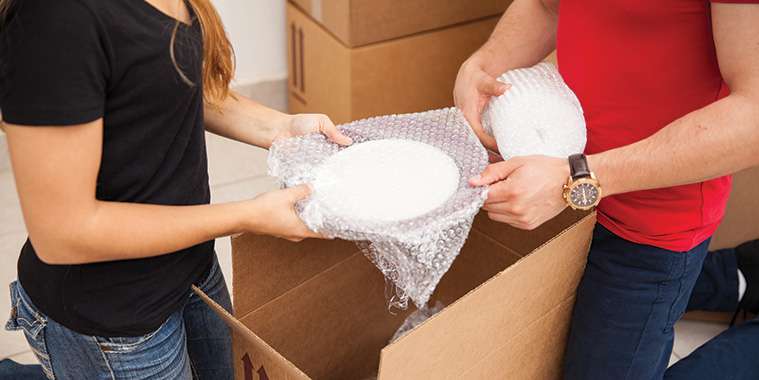No matter how carefully you plan for a move, we’ve got bad news for you. Odds are, there are at least a few things you’ll pack all wrong. Why should you care? Because, of course, possessions that aren’t packed well tend to break. Here’s how to do it right.
1. Cleaning supplies
Cleaning supplies and other potentially hazardous household materials are common things that people tend to pack incorrectly.
People tend to clean up until they move, meaning everything from bleach to tile spray is simply thrown in a box at the last minute. During a bumpy move, these containers can open up and create a leaky mess — or worse, toxic mixtures. Instead, tightly pack chemicals and cleaners in an upright position so they can’t open or spill in transit.
2. Flat-screen TVs
Many people pack their flat-screen TVs flat, or horizontally. But that’s a risky move, since these screens are built to have their weight balanced when set upright. This means when you lay the screen flat, there won’t be adequate support in the middle, which can lead to cracking or distortion of the edges.
Add in the vibrations of the moving truck, and the chance of cracking or distortion only increases. Pack your TV correctly in a specially made vertical box and protect the front with a moving blanket.
3. Anything with electrical cords
As for TV cords and remotes, they tend to get thrown into a bundle without proper labeling — which makes reconnecting them later a huge headache. Preserve your ability to binge-watch by snapping photos of which cords go where before disassembly. Then label every cord, and tape remotes to the devices they belong to.
4. Books
The issue is not hurting a book, but injuring yourself by overpacking a box with tomes.
Don’t put all your books in one container. Sure, it’s convenient to know where all of your books are. But a box of 30 hardcovers will be unwieldy and prone to collapsing under the weight. The best way to pack your favorite reads is to distribute them among all of your boxes. Pack several books on the bottom and then add lighter items on top.
Another tip — most people pack books with the spines up so they can see the titles. But it’s better to pack books flat to protect the spine.
5. Dishes
People tend to pack dishes in stacks — big mistake! In a flat stack, all the pressure rests on the bottom dishes. It turns out dishes stacked on their side are much less likely to break.
Just like eggshells, plates are strongest on their edges. Dishes should be well-wrapped in paper with sections divided by cardboard pieces in a special dish-pack box. Be sure to also push crumpled paper down around each side and on the top.
6. Unusually tall items
The taller the item, the more interesting the bad packing becomes.
People will wrap items such as a tall vase or grandfather clock in a rug, or buffer them with a combination of blankets and duct tape. This creates a bulky object that’s not only difficult to move but also vulnerable to breakage.
A better solution is to take two moving boxes and create one suitably sized and easily packed carton taped together like a clamshell. Place the breakable item within the clamshell. And remember to pad the bottom and top of your custom box well and fill it with paper stuffing so everything sits snugly inside.
7. Anything in bubble wrap
Delicate ceramics and glass items will be safe and
snug in bubble wrap, right? Not if you consider a new study commissioned by Duck brand packing supplies, which found that 2 out of 3 people don’t know how to use bubble wrap right.
So what’s the secret? Here goes: The bubbles should face toward the item you’re wrapping, rather than away. This is because the purpose of the bubbles is to cushion the item and hold it in place as it bounces in the back of a moving truck; bubbles can do that only if they’re touching the item that needs protecting.
— realtor.com



